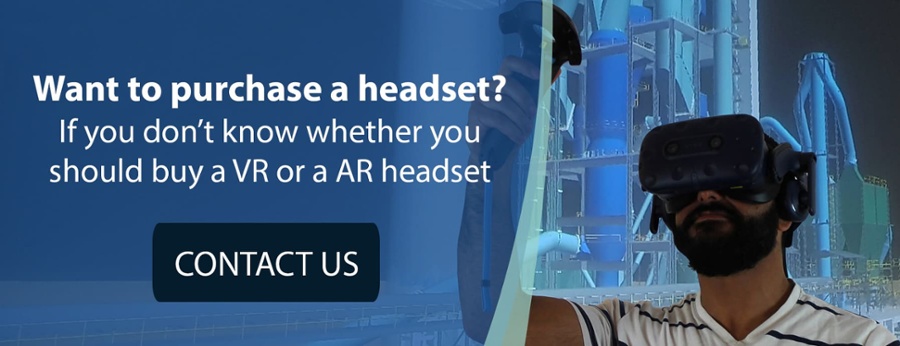At its WWDC 2023 keynote, Apple finally unveiled Apple Vision Pro, its long-awaited mixed reality headset. Even if most of the features had already been leaked to the press, the moment is still dramatic.
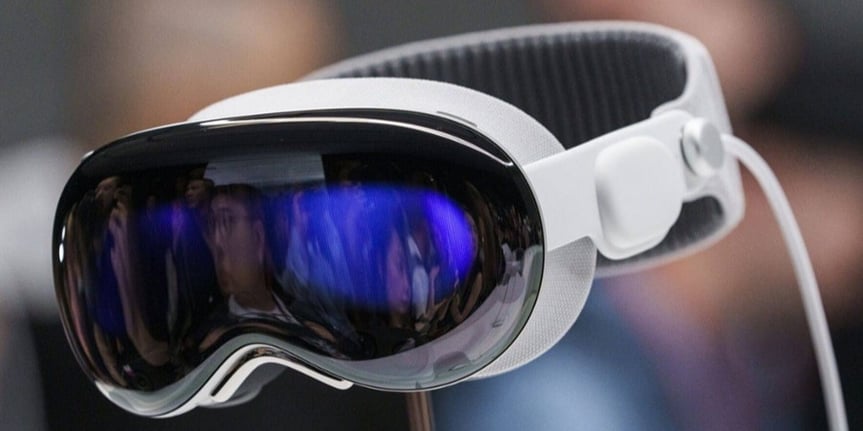
A Turning point for XR
At first, it looks like an exercise in a business school. Given the records of Apple to choose a market and come with a product that leapfrogs all others, what would an Apple XR headset look like? Think about what was different between the Macintosh and the IBM PCs or between iPod and other mp3 players at that time. From this, extrapolate an Apple XR headset in 2023!
But this is not a student project. The product is real, it's almost ready and will be available to consumers in a not-so-distant future. We are not talking about a Kickstarter project here. The whole thing is real.
This is the second time that the XR market gets such a blessing by a big player. The last time was when Facebook jumped in. The fact that such a big company supported the technology had a ripple effect and it gave a boost to the XR industry launch.
It is very likely that the Apple Vision Pro will have the same level of impact.
A quick glance at the Features
Unfortunately, at TechViz, we did not get the chance to test the headset, so we must rely on other’s hands-on experiences and announced features. Fortunately, the keynote came with a complete range of details of each feature, as well as use cases and benefits.
Some features are totally new for a commercial product, such as the EyeSight screen that lets others see your face. Some others have already been available on other HMDs (eye tracking, face tracking, head tracking, video passthrough, hand tracking, 2D apps integration, full-screen videos...) but the Apple's ones offer a much higher quality.
“Apple Vision Pro relies solely on your eyes, hands and voice You browse the system simply by looking. App icons come to life when you look at them; simply tap your fingers together to select, and gently flick to scroll.”
Alan Dye -Apple vice-president of human interface design
At TechViz, our software has supported Mixed Reality headsets for a long time (e.g., Canon MREAL in 2006), hand interaction with Cyberglove in 2005, and eye tracking with SMI in 2016 (the company was bought by Apple).
But the key aspect here is not the numbers. The most important question is whether the device will be a perfect consumer product that truly performs the tasks it was designed for, is easy to learn, and enjoyable to use. And that's where the Apple DNA comes in.
While other VR headsets have incrementally improved their performance and quality over the years, the Apple HMD has been designed differently. Even the rumor that Apple design teams had blocked the release of the previous iteration as it was not good enough might be true.
Typically, the lucky ones who experienced the device firsthand have remarked that it represents a breakthrough in passthrough headsets. They have reported that the hand-tracking user interface is genuinely user-friendly and accessible for newcomers. Plus, the passthrough quality and latency provided them with a significantly improved experience during longer sessions.
“With Vision Pro, you’re no longer limited by a display. Your surroundings become an infinite canvas,” . “Vision Pro blends digital content into the space around us. It will introduce us to Spatial Computing.”
Tim Cook - Apple chief executive
What about VR?
One thing that has surprised our XR experts is that very little was said about displaying 3D content, which has been the very priority of virtual and augmented reality headsets until now. Some 3D models were displayed during the keynote for a few seconds during a manufacturing project review, AR remote support and gaming.
Some have wrongly assumed that the Apple Vision Pro will not make a good headset for visualizing 3D content or gaming. However, it is obvious that this HMD will be an excellent product for the Virtual Reality, given its resolution, the performance of the CPU/GPU as well as of the inside-out tracking/hand tracking and the quality of the programming platform.
However, there is a strong reason to believe that third-party companies are already working to provide controllers as an aftermarket accessory.
Impact on the XR industry
Most XR headsets until now have either been marketed as gaming platforms or professional tools. The main use cases for professionals are training, sales, design review and remote support.
During the keynote, the device was presented as covering all the possible range of uses, whether personal or professional. One device that replaces them all. This is far-reaching and very ambitious.
If we focus solely on the device's potential within the mentioned use cases, the integration of 2D content (such as smartphone apps, web browsing, video, and conferencing) alongside VR content has the potential to significantly enhance the technology's adoption. By simply reducing the number of times you need to turn the device on and off will make the immersive virtual reality technology more user-friendly and accelerate its development. We hope to see that in action very soon.
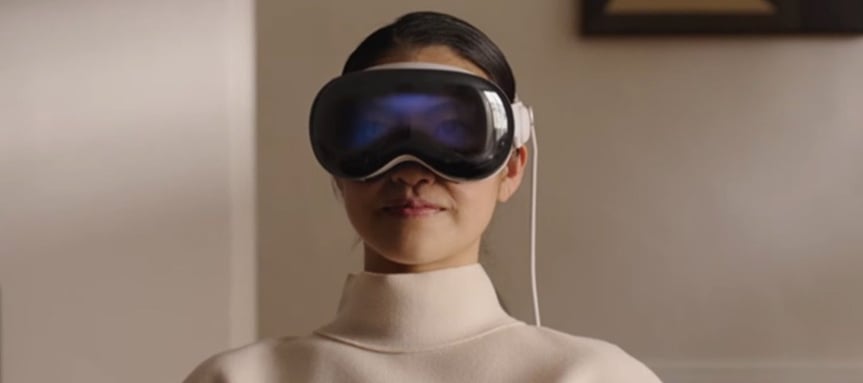
Right now, the very fact that the device is made by Apple and is enjoyable to use might be enough for it to succeed. In the B2B market, the price is not going to be an issue, given the return of investment of the technology in many use cases.
Integration into the TechViz Software Suite
Since 2004, TechViz's policy has been to integrate every XR device that our customers are willing to purchase. We have already received questions and have already made plans for the integration of Apple Vision Pro. As our software is platform- and OS-independent, we do not see any challenge for this. The only obstacle is the current unavailability of the device and, therefore, our inability to test and refine the fully immersive experience.
Running our software will be easy. However, we believe that to fully leverage its capabilities, we will need to go beyond simple porting. We might also want to integrate our avatar system, originally designed for our collaboration platform. The integration of 2D content into Mixed, Augmented, and Virtual reality meetings as well as regular collaboration will become real.
TechViz allows users to make real-time changes to the virtual prototype within the 3D software, with the ability to see the results in XR. Currently, this involves one user making changes on a PC desktop and the other one viewing the results in XR. Directly performing these actions in XR has never been feasible due to the challenge of capturing the desktop image. With the high-quality screen of the Apple Vision Pro, we have strong confidence that this may now become achievable."
Our XR Space collaboration platform enables multiple people to interact simultaneously in both a physical space and a virtual world (a concept we refer to as the "PhyGital" setting). To facilitate this interaction, each participant is required to wear a headset. The Eyesight feature will allow for the visualization of team members who are not wearing XR devices within the same environment, thus enhancing collaboration and reducing the sense of isolation inside XR.
Detailed Features/Functionalities Overview
EyeSight: an interesting feature for the XR collaboration
"Your eyes are a critical indicator of connection and emotion, so Vision Pro displays your eyes when someone is nearby. Not only does EyeSight reveal your eyes, it provides important cues to others about what you're focused on."
Alan Dye -Apple vice-president of human interface design
With the EyeSight, instead of the shiny black exterior of the Vision Pro, collaborators around you can see a display of your eyes. This feature might mitigate a “default” on HMDs for group sessions. A headset is typically giving a deeper sense of immersion than other hardware technologies for professional VR, such as immersive rooms and VR walls.
High-end specs to justify a sky-high price
The headset has been designed to display content within 12 milliseconds – 8 times faster than the blink of an eye. Apple Vision Pro is designed for all-day use when plugged in, and up to two hours of use with its external battery.
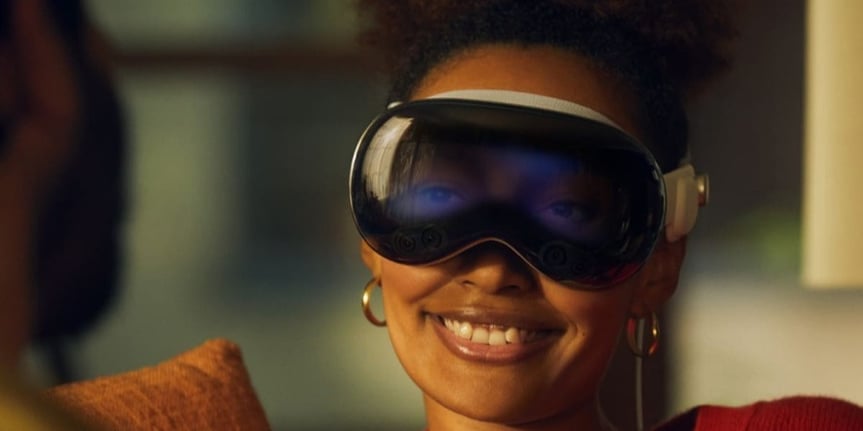
Powering the Vision Pro are two chipsets that propel its capabilities to new heights:
- The same M2 you find in some of the best MacBooks – it enables you to run most iPhone/iPad apps natively (e.g., Final Cut Pro) and may offer good Mac apps rendering in the future (currently not supported)
- The R1 that processes input from 12 cameras, 5 sensors, and 6 microphones for the XR experience.
On top of these powerful processors, the Vision Pro boasts a 4K micro-OLED display for each eye. According to Apple, it fits 64 pixels into the same space where the iPhone's screen fits one single pixel.
Conclusion
The revolutionary MR Headset by the Cupertino-based tech giant holds great promise, offering a range of anticipated features and advancements in Mixed Reality technology. This innovative device is expected to revolutionize the way users interact with both the digital and physical worlds. It is expected to cater to various use cases, especially for training/simulation. We hope that we will not wait too long to be able to work with the device and make it compatible with our 3D Model Visualization middleware.
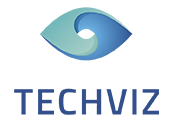





 Back to Blog
Back to Blog
